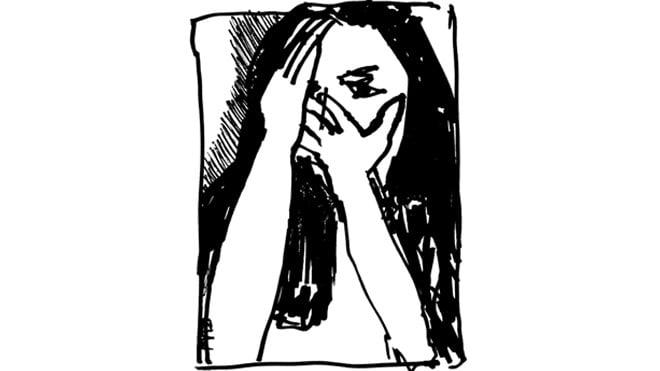
To understand violence against women in all its complexity, we need to go beyond its truncated and one-sided images

During the past year or so, mainstream Pakistani media has witnessed a renewed attention to instances of violence against women, including high profile cases of rape and honour crimes. This has rekindled a decades-old debate on the need to reform legislation pertaining to women’s rights, while simultaneously inviting the ire of the misogynist, religious right as well as men’s rights crusaders from more liberal backgrounds.
While this debate has asked very pertinent questions regarding Pakistan’s criminal justice system and legislative loopholes that make it easy for perpetrators of violence against women to walk free, another related query remains much less easy to answer, i.e., what is it about our social and moral universe that makes gendered violence so pervasive and ubiquitous, and yet so invisible and easy to deny?
Turn on any entertainment channel on your cable on weekday mornings, and you see a certain kind of television programming aimed at ordinary female audiences: the morning show. Besides its bizarre lack of substantive content, these shows promote a certain facile ideal of femininity, one that is ornamental, obsessed with its body image, and enactments of fake wedding grandeur.
But the most telling aspect is perhaps how these shows indulge in overt forms of internalised misogyny: in a recent episode on one such show, two female debaters were invited to speak for and against marriage. While they defended opposite positions, they both chose to use the male voice: it was wives who are troublemakers and a major cause of headaches for their husbands. At the end of the segment, the female host, in fits of laughter, wondered why was it that only husbands were so aggrieved; she had never heard of any instances of Pakistani wives being unhappy in their marriages!
Read also: "Laws are a critical starting point"
In a country where domestic and intimate partner violence is so common, and which had just gone through a very public wrangling over a domestic violence bill, such a statement, on popular media which boasts of female audience numbering perhaps millions, belies what is at stake: the normalisation of misogynist discourse which is sine qua non for creating an environment where women’s bodies are so vulnerable that for the most part, their violation does not even prefigure in our imagination as an event. It is perhaps little wonder that legislation, no matter how punitive, fails to prevent such violence from being the norm.
So what is it about the bodies of women that makes them the recipient of violence? For starters, it is important to recognise that violence is normalised not just for cis-women, but for many kinds of ‘deviant’ or ‘expendable’ bodies. Trans-gender people, for instance, are especially prone to gruesome forms of violence, as borne out by recent attacks. Similarly, from Baldia Town factory fire to gas explosion in Gadani, the bodies of labourers and factory workers are always one step away from sacrifice at the alter of development. Are these violence’s somehow distinctive in essence, or are there common threads running through them?
In her book, Caliban and the Witch: Women, The Body And Primitive Accumulation, Silvia Federici, an Italian-American feminist scholar has argued that not only has the human body become a central site of control under capitalism, the transition from feudalism to capitalism was in many ways dependent on the way the abilities of specific bodies were put to use. Women’s bodies then, with their ability to re-produce, are a central resource for the capitalist system, to control and exploit, right alongside land-grabs and the enclosure of the commons.
Read also: Towards social contexts
Violence against women can, therefore, only be understood in the context of the entire economic and productive framework of society, a framework in which trans-bodies are violated for transgressing sexual norms, and labouring bodies are the fodder that keeps the productive machinery running.
In other words, in a system where life is subordinated to the production of profit, growth and progress can only be achieved with the maximum of violence so that, "violence itself becomes the most productive force". Gender violence, consequently, needs to be read in conjunction with, rather than in opposition to, class and other forms of violence.
During my work at the Punjab Women’s Helpline, these insights were abundantly clear. Not only was the everyday form of domestic violence the most reported complaint from women, it was precisely this violence that slipped through the cracks the most. A push or a shove, verbal abuse, a few slaps, even if they were a routine matter that terrorised women, did not invite the sympathy of the criminal justice system, i.e., they were invisible, expected, normal.
When women refused to leave abusive relationships, it was not simply a matter of tradition, but an indictment of the very political economy which kept women out of certain kinds of knowledge networks (how do we access property documents or even know what property our male relatives own?), economic dependence (only certain kinds of work is readily available to women, and poor families often cannot afford to feed married/divorced daughters) and denied them access to community support, especially in urban settings (harassment by relatives, neighbours and friends of the abuser as they move through the neighbourhood) which was readily available to men.
To understand violence against women in all its complexity, we would need to go beyond its truncated and one-sided images presented in the reports of international NGOs and government agencies. What is required is a deeper, and more sustained, academic and activist engagement in the Pakistani context to understand the intersections of various forms of violence, and their historic trajectories that continue to produce and re-produce vulnerable bodies.